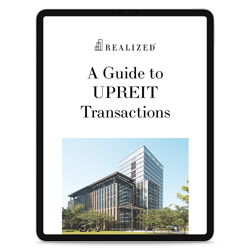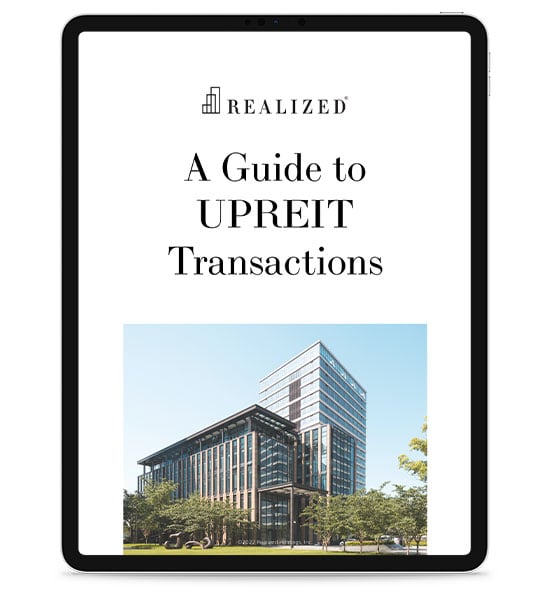
An UPREIT, which stands for Umbrella Partnership Real Estate Investment Trust, allows owners of appreciated real estate to transfer a property from individual ownership into a trust in exchange for shares in the trust. This exchange is also known as a Section 721 exchange, which is designed to allow the investor to defer capital gains taxes.
This structure allows investors to continue to potentially benefit from property even after transferring ownership.
What is an UPREIT?
An UPREIT is an arrangement made between the property investor and REIT to transfer the ownership of appreciated real estate, also known as a 721 exchange. Unlike typical transactions, the property is not sold for cash but instead, the owner received operating partnership (OP) units in the REIT, equal in value to common stock. If the property was sold for cash, it would create a taxable event and the property owner would be liable for capital gains taxes. Using OP units means the property owner can defer capital gains until:
- The OP units are sold
- The OP units are converted into REIT shares, or
- The REIT owner sells the contributed property
The exchange is allowed by IRC 721 and gives the same tax-deferral benefits as a 1031 exchange. Keep in mind that the property must be one that the REIT wants to add to its portfolio, which can bring some challenges. Finding an interested REIT to acquire the property may take some time and if the REIT decides to sell the property at a later time, it will trigger a taxable event.
Why were UPREITs created?
REITs (Real Estate Investment Trusts) were first introduced by Congress in 1960 to give investors better access to income-producing real estate. Prior to its introduction, income-producing real estate investments were only attainable for the wealthy or large investors.
In 1960, the Cigar Excise Tax Extension law allowed REITs to own and finance real estate investments. The Tax Reform Act of 1986 gave REITs the ability to operate and manage investment properties as well. As REITs evolved, alternative structures, like UPREITs, entered the market.
The UPREIT structure was created to allow investors to contribute appreciated property for shared ownership and to avoid the recognition of gain.
Is an UPREIT a good investment?
Since their introduction, UPREITs have been a popular investment option that seeks to provide income for their stakeholders. It’s no surprise, considering the potential advantages that aren’t available through conventional real estate transactions. Some of these include:
- Liquidity
- Passive investing opportunity
- Tax advantages
- Potential income
- Diversification
- Estate planning with a step-up in basis
However, there are risks associated with any type of real estate investment and UPREITs must be thoroughly evaluated before deciding to invest. Here are some terms to be aware of when evaluating an UPREIT investment:
Net Asset Value (NAV): This is the estimated market value of the UPREIT that determines the share price of the trust. To calculate the NAV, take the asset value of the trust and subtract the value of its liabilities. To calculate the share value, the NAV is divided by the total outstanding common shares.
Funds From Operation (FFO): This is used to evaluate the financial health of an UPREIT, which is more beneficial than earnings per share. The FFO shows the cash flow from operations of the REIT and is determined by adding depreciation, amortization, and losses on sales of assets to earnings and then subtracting gains on sales of assets as well as any interest income.
Adjusted Funds From Operations (AFFO): The AFFO considers the costs to operate the properties in the trust such as maintenance, repairs, and capital expenditures.
EBITDA: This stands for Earnings Before Interest, Taxes, Depreciation, and Amortization and is used to evaluate operating performance. EBITDA to interest expense ratio can be used to measure the potential risk of a REIT and to assess its debts.
Credit rating: This can be used to evaluate the outlook for an UPREIT that has performed in the past and is helpful when assessing the debt of a REIT.
Cost of capital: This is a tool used to make better decisions on where to allocate capital. This is similar to the rate of return expected from an investment.
How does an UPREIT transaction work?
UPREIT transactions are fairly simple and it’s done using a 721 exchange. The investor’s appreciated real estate property is contributed to a REIT in exchange for operating partnership units. The REIT is the umbrella partnership that owns most of the OP units. Instead of selling the property, the investor can defer capital gains taxes by trading the property for OP units.
However, this type of direct 721 exchange rarely happens, and investors usually use a different strategy that involves two steps.
- The investor sells the relinquished property and structures it as a 1031 exchange. Instead of searching for a replacement property, the investor would identify and acquire real estate that the REIT has already designated.
- Next, the fractional interest is contributed to the operating partnership after a holding period of 12 to 24 months (as part of the 721 exchange). The investor receives an interest in the operating partnership in exchange for the contributed property.
How do I get income from an UPREIT?
Investors may use UPREIT structures for their income potential and tax benefits.
If an UPREIT is increasing in value, an UPREIT investor can exchange their units in the trust for shares, which can be sold and cashed out. The majority of UPREITs are publicly traded and are structured like a corporation. When shares are sold and the UPREIT sees profit, the investor will earn the difference between the value of their original share and the value of the share when it’s sold. Investors can also enjoy potential income from dividends of a profitable UPREIT. However, potential cash flow can fluctuate.
What are the disadvantages of an UPREIT?
While we’ve listed all the potential benefits of an UPREIT — tax advantages, potential income, liquidity, etc. — there are bound to be some drawbacks. Here are a few known disadvantages of an UPREIT:
- Limited voting rights: OP unit voting rights are limited and would only apply to matters that affect the rights of the holders, such as distributions, redemptions, and tax allocations.
- Lack of control: Once assets are contributed, the REIT is the owner of the property and assumes full control.
- Volatility: Share values can change based on stock market volatility, management, valuation of the property, financing deals, or other transactions.
- Filing requirements: REIT shareholders are required to file income taxes in their state of residency, and OP unitholders are required to file taxes in each state in which the operating partnership conducts business.
The UPREIT is a unique, tax-deferral partnership and investors should investigate this structure to learn more about everything it has to offer.



